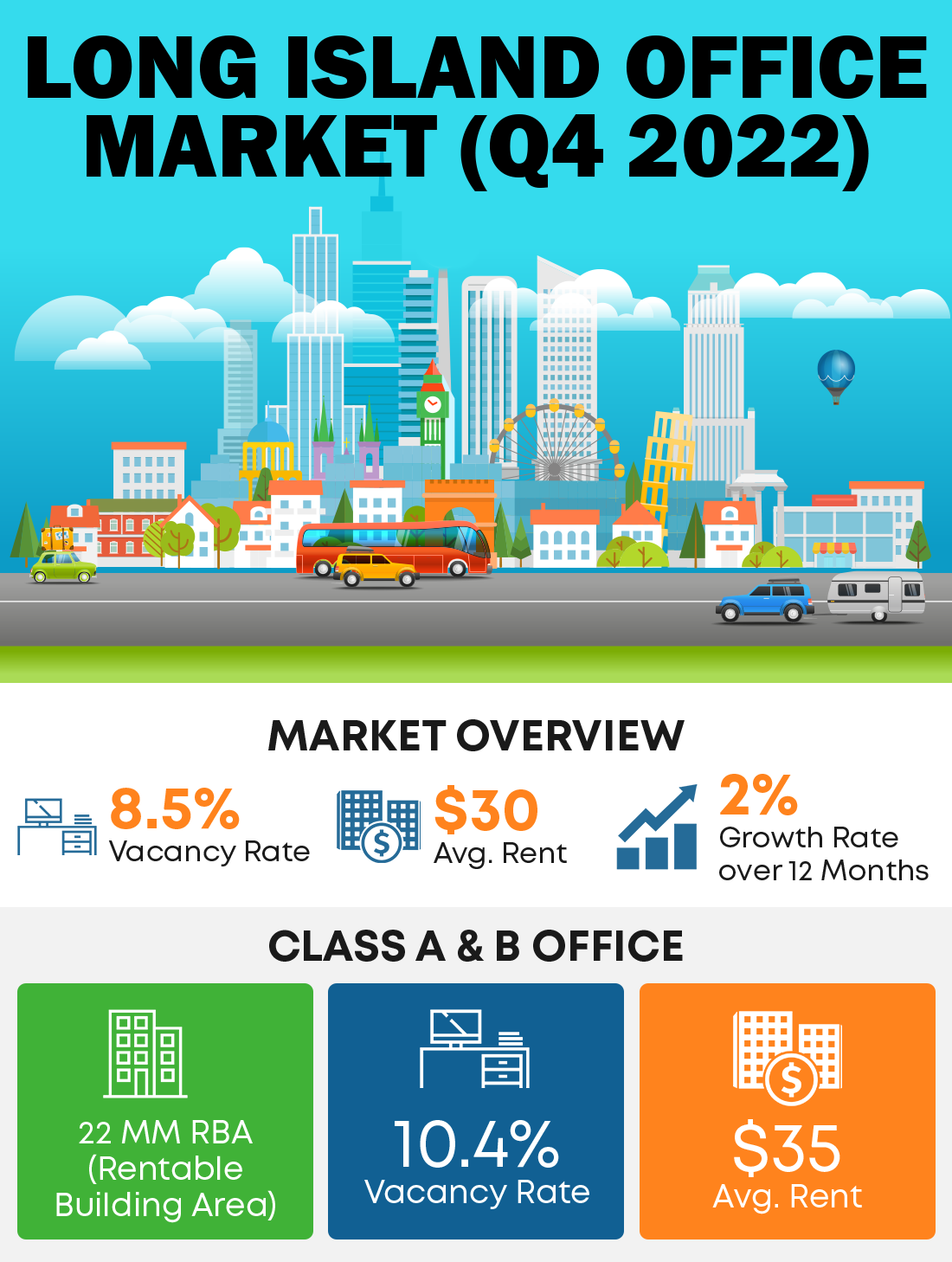In this article, you'll learn:
- Why companies are migrating to suburban areas like Long Island.
- The advantages of Long Island’s commercial real estate market.
- The disparity in leasing activity between Class A and Class B office spaces.
- How better office buildings are crucial in attracting top talent in today’s competitive market.
Maybe as a Long Island, NY based company we’re biased....But how can you beat the quality of life out here?

Well, the data suggests that we’re not alone in this belief. With industrial vacancies at record lows and rents slowly climbing according to demand, this major suburban market is steadily climbing. Companies are packing up, driving over the bridge, and into their new suburban Long Island location.
But it’s not just here. Some companies have found it may no longer be the best option for them to be located in expensive cities. Given the new workplace freedom, suburban commercial leasing activity has skyrocketed.
In this article, we will cover why companies are rushing to the suburbs, more about Long Island’s stats in particular, and why companies want better office buildings.
 Source: iOptimize Realty® Market Research
Source: iOptimize Realty® Market Research
The Long Island Commercial Leasing Market
Long Island commercial leasing activity has been on the rise in recent years, driven by an influx of new businesses and a flight to quality among tenants.
Long Island represents one of the most prominent commercial real estate markets in New York. Not only is it close to Manhattan, but the quality of life and environment deliver on promises that metropolitan areas can’t offer, including:
- Better safety
- Lower rents
- More transportation options
- Ample parking / No tolls
- Overall more bang for buck
LI growth comes at the expense of Manhattan’s market. Office lease transaction volume has been downhill since the pandemic. However, this phenomenon is being seen across the board. Suburban areas across the country have been revitalized by demand from people fleeing the cities for health and safety since the pandemic.
And this is having a huge impact on the value of commercial real estate in these markets.
|
"Price growth among urban properties has significantly trailed that of suburban properties since the pandemic began." -FS Investments |
The inflated costs of cities are no longer sustainable for companies, families, and individuals. Instead, Americans in general have found an improved quality of life in the suburbs since the power of the dollar goes further.
More Affordable Office Rents
In Long Island, one can observe the price differential between suburban and metro areas as glaringly obvious.
|
Long Island office rents have grown 2% in the past year, now averaging $30 per square foot. Data according to iOptimize Realty® market research |
So, even though property values are steadily climbing with demand, let’s put it in perspective. Even though there has been a 2% increase, CRE rents on Long Island are literally one third of what you would pay for a commercial office in NYC.
The average square foot of Class A office space in NYC is $91 with premium buildings even reaching a staggering $300 per square foot. But for the sake of this exercise, let's say you get an okay deal in NYC and pay average on Long Island. Look at the price difference a tenant with 50,000 square feet could expect over a ten-year lease (without even counting rent escalations, OpEx, etc.).

Read more about The Manhattan Rent Crisis.
The point is that by packing up and moving to Long Island, companies can save millions on their leases, cutting out at least two thirds of their total cost in Manhattan. Not to mention, that you’ll likely get more bang for your buck in the suburbs with more affordable amenities, and parking.
Escape Strict Metropolitan Regulations
Not only are suburbs more affordable, but cities in general traditionally are held to stricter regulations across the board. For example. New York has planned to wage a war of carbon neutrality.
Landlords will be expected to hold their buildings to far stricter sustainability standards. And who do you think will be getting the bill for all the upgrades? That’s right. Most landlords will likely attempt to pass through the cost to the corporate tenant. While this is happening in Manhattan, it’s not an isolated phenomenon.
Major metros like Washington D.C., San Francisco, Boston, and many others are also pushing hard and fast goals for a stop to greenhouse gases. So, as more of these laws go into practice, it’s time to take notice. If it hasn’t happened in your city yet, it’s in your backyard. Depending on your location, your responsibility to adhere to these regulations will vary, but corporations especially in metro areas will feel the effect of this trend toward sustainability.
If even ever, suburban municipalities will be slower to integrate such laws. As a result, corporate suburban tenants will be able to catch yet another break.
LI Leasing Across A and B Class Offices
While Long Island commercial real estate has witnessed progress, it is only in certain pockets. As companies reevaluate their pre-pandemic working environments, another trend has emerged. There is a new emphasis placed on bringing employees back to the office with premium features and upgraded spaces.
As a result, in Long Island there is a disparity in leasing activity across Class A and Class B buildings.
|
“If you look at the top 45 office buildings on Long Island, there’s like a 7 percent vacancy rate, but as you go to the broader market, it’s at 13.5 percent.” -Long Island Business News |
There were 582,704 square feet of Long Island Class B office space leased in 2022, while slightly more than 1 million square feet of Class A offices leased in the same period. This is a stark contrast to 2021 when 783,949 square feet of Class B office space were leased compared to 760,842 square feet of Class A buildings.
| Class A Offices | Class B Offices | |
| Sq. Ft. Leased 2021 | 760,800 | 784,000 |
| Sq. Ft. Leased 2022 | 1,000,000 | 583,000 |
Class A Offices vs Class B Offices
The differences between Class A and B properties are significant; Class A offices are modern with premium amenities, on-site parking, more centrally located, etc. While Class B buildings are often older structures with limited features or amenities. Furthermore, many Class B properties tend to be located outside of city centers which can limit access for potential customers. As such, businesses looking for better accommodations have been willing to pay higher leasing rates for the better facilities found in Class A offices.

In addition to these factors driving up occupancy rates at class A buildings, economic conditions have also played a role in the flight to quality movement in Long Island's commercial real estate market. These trends suggest that demand for Class A office spaces could continue or even increase in 2023 and beyond as tenants seek out higher-quality facilities and amenities over cheaper rents or outdated infrastructure of Class B properties.
Better Offices Recruit in The War for Talent
With this trend expected to remain steady or even accelerate further down the line, it touches on the fact that companies are getting more competitive on all fronts to lure in top talent. To bring people back to the office, it needs to be an office that people actually want to go to.
Accordingly, corporations have become more willing to pay a premium for quality accommodations that they expect from Class A locations. This push for better buildings has further devalued Class B properties, as a result there is a bigger delineation in the asset classes.
Traditional office buildings are now being likened to the “gas guzzlers” of commercial properties: Outdated, not energy efficient, and run down. As a result, there is overwhelmingly negative investor, tenant, and overall consumer interest in such buildings. In a talent war, companies with stronger commercial real estate properties stand out.
Top talent will not put up with out-of-date offices especially after being given the freedom of workplace flexibility. As a result, the demand between Class A and B properties will likely only grow.
Make the Right CRE Decisions in Any Market
During this era where the country’s strongest performing companies are reassessing their real estate needs, don’t get left behind. You have the power to make similar, hard looks at your CRE. If you’re located in NYC (or any city) you’re at a higher risk for crime and skyrocketing cost of living. It’s time to determine whether the cost is worth the environment.
Because, while the city CRE sector is taking a big hit, the suburbs represent an opportunity for growth. As businesses can afford to be more flexible with the location of their real estate, suburbs are gradually replacing metro areas as the prime spot for commercial real estate.
As True Tenant Reps™ at iOptimize Realty® who only represent corporate tenants, we have observed the trend towards suburban offices. So, if you want to take similar, close looks at your CRE, we can help. We know the plusses and minuses of being in an urban area versus suburban. So whether you want to stay in the city or go to the 'burbs, we can help.
With over 3 decades of experience solely representing Fortune 500 and top private organizations on their corporate real estate, we know how to save you potentially millions of dollars!
Talk to a True Tenant Rep™ at iOptimize Realty® today!
Wondering where to begin?
Related Content
- Which Types of Offices and Markets Will Survive? (Beware the Red Flags)
- Office Concession Rates on the Rise: Leveraging Increasing Concession Ratios
- Commercial Property Classifications & Types of Office Spaces
- Converting Empty Offices: 4 Cities with the Most Office Conversions






